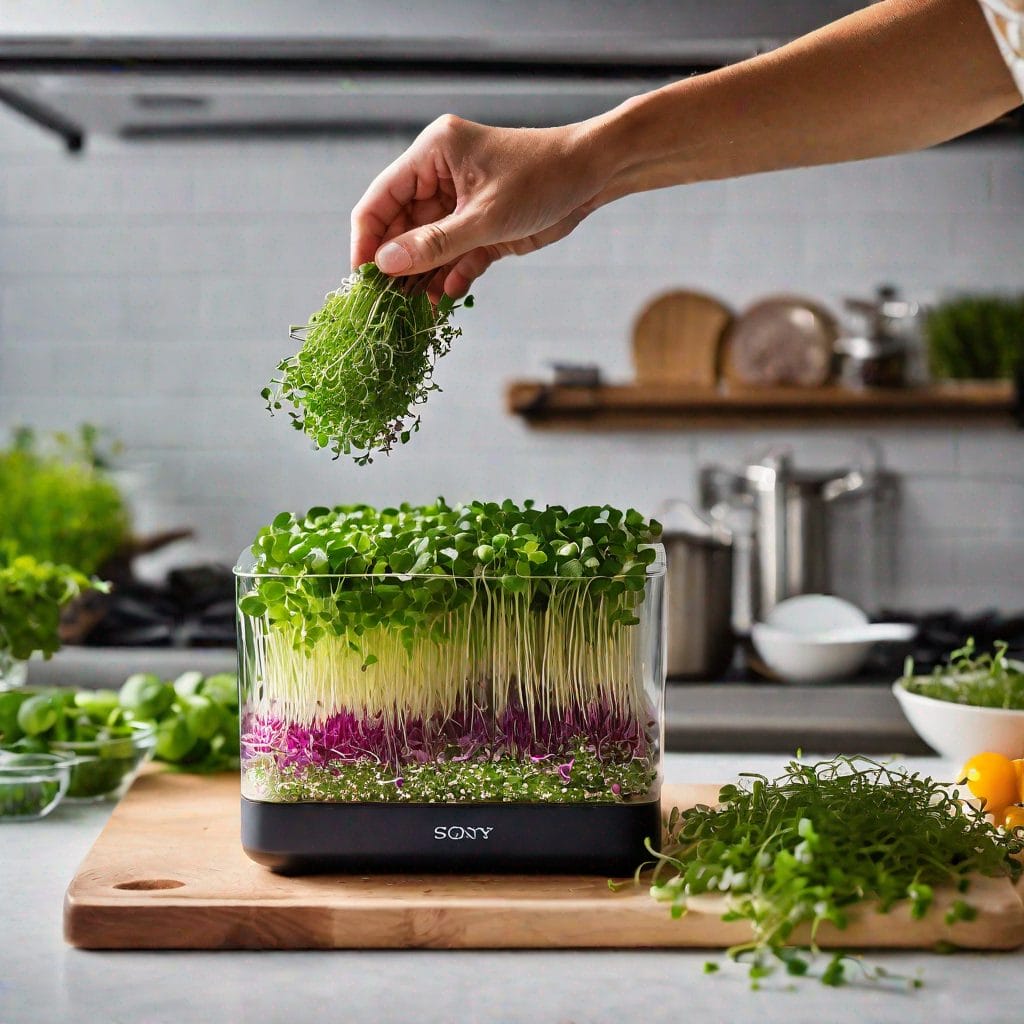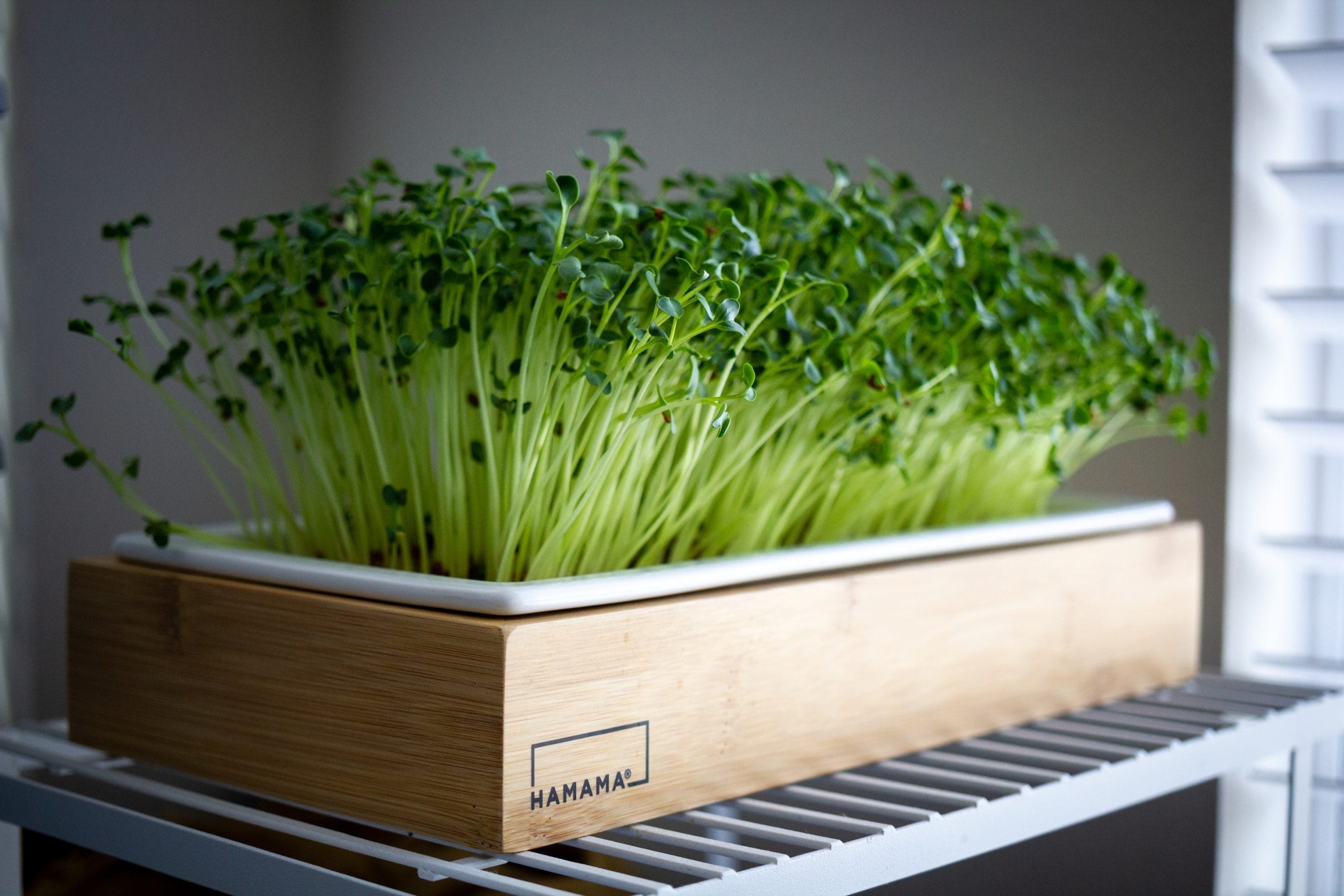Are you looking to keep your microgreens fresh and bursting with flavor? Look no further. Our expert advice will guide you on the best methods to store and maintain the quality of your microgreens.
Learn how to choose the right storage containers, control humidity levels, and handle and wash your greens effectively. With our tips, you can extend their shelf life and enjoy the freshest microgreens every time.
Get ready for a culinary journey that will leave you feeling satisfied and accomplished.
Key Takeaways
- Use airtight containers and line them with a paper towel to maintain freshness and prevent wilting and spoilage.
- Opt for airtight and moisture-resistant containers, such as glass jars with tight-fitting lids or food-grade plastic containers with sealing mechanisms.
- Control humidity levels using a hygrometer, maintain an ideal humidity range, and store microgreens in breathable containers.
- Store microgreens in a cool and dark place, maintaining temperatures between 35-40 degrees Fahrenheit and avoiding direct sunlight exposure.
Storing Microgreens Properly

When storing microgreens, it’s important to keep them in an airtight container to maintain their freshness and flavor. This will help prevent moisture loss and protect them from exposure to air, which can cause wilting and spoilage.
Choose a container that is the right size for your microgreens, ensuring they are not overcrowded or crushed. Additionally, ensure the container is clean and dry before placing the microgreens inside.
To further extend their shelf life, you can line the container with a paper towel or a clean kitchen towel to absorb any excess moisture. Remember to store your microgreens in the refrigerator, preferably in the crisper drawer with higher humidity levels.
Choosing the Best Storage Containers
Using the right storage containers is essential for maintaining the quality of your microgreens. When choosing the best storage containers, there are a few key factors to consider.
First and foremost, opt for containers that are airtight and moisture-resistant. This will help prevent moisture loss and keep your microgreens fresh and flavorful for longer. Glass jars with tight-fitting lids or food-grade plastic containers with sealing mechanisms can be great options.
Additionally, consider using transparent containers that allow you to easily see the contents without opening them frequently, as this helps minimize exposure to air and light.
Controlling Humidity for Freshness
To maintain the freshness of your microgreens, you’ll want to ensure that you’re controlling humidity levels effectively. Humidity plays a crucial role in preserving the flavor and texture of these delicate greens.
Here are three ways to control humidity and keep your microgreens fresh:
- Use a hygrometer: Invest in a hygrometer to monitor the humidity levels in your storage area. This device will help you maintain an ideal 40-50% humidity range.
- Proper ventilation: Good airflow is essential for preventing excess moisture buildup. Ensure proper ventilation in the storage space by using fans or opening windows if possible.
- Store them correctly: Place your microgreens in breathable containers like paper bags or perforated plastic bags to allow for air circulation while still retaining some moisture.
The Importance of Temperature Control

When storing your microgreens, understanding the optimal storage conditions is crucial. Temperature control plays a significant role in preserving their taste and texture.
Optimal Storage Conditions
Store your microgreens in a cool and dark place to maintain their freshness and flavor for best results. Here are three key factors to consider when storing your microgreens:
- Temperature: Microgreens thrive in cooler temperatures, ideally between 35-40 degrees Fahrenheit. This helps slow down the wilting process and extends their shelf life.
- Moisture: Excess moisture can cause microgreens to become soggy and lose their crispness. It is important to store them in a dry environment or use paper towels to absorb any excess moisture before placing them in airtight containers.
- Light exposure: Microgreens should be kept from direct sunlight, which can lead to discoloration and nutrient loss. Store them in opaque containers or cover them with a dark cloth.
Impact on Taste
Storing microgreens in the proper conditions will help maintain their taste and quality. When it comes to freshness and flavor, the way you store your microgreens can make a significant difference.
Keeping them at the right temperature and humidity levels is crucial to preserve their delicate taste. Microgreens are best stored at around 40°F (4°C) with a relative humidity of about 95%. This ensures that they stay crisp and flavorful for longer periods.
It is also important to handle them gently, as rough handling can damage their delicate leaves and compromise their flavor.
Shelf Life Extension
To extend the shelf life of your microgreens, you’ll want to ensure they are stored in optimal conditions. Here are three important tips to help you keep your microgreens fresh and flavorful for longer:
- Temperature: Microgreens thrive in cool temperatures, so storing them in the refrigerator at around 35-38°F (2-3°C) is best. This will help slow down their metabolic rate and prevent wilting.
- Humidity: Microgreens require a specific moisture level to stay crisp and vibrant. Place a damp paper towel or cloth over the microgreens to maintain optimal humidity levels before storing them in an airtight container or resealable bag.
- Airflow: Proper ventilation is essential for preventing moisture buildup and maintaining freshness. Make sure not to overcrowd your storage container and allow some space for air circulation.
Handling and Washing Techniques
When handling microgreens, gently rinse them under cold water to remove dirt or debris. This step is crucial in ensuring the freshness and flavor of your microgreens.
After rinsing, pat them dry using a clean kitchen towel or paper towel. Avoid rubbing or squeezing the delicate leaves, which can bruise or damage them.
Once dried, transfer the microgreens to an airtight container lined with a damp paper towel to help maintain their moisture levels. Store them in the refrigerator’s crisper drawer to keep them fresh for longer periods.
Remember to check on your microgreens regularly and discard any signs of wilting or decay.
Extending Shelf Life With Proper Handling
When it comes to extending the shelf life of microgreens, there are a few key points to keep in mind.
First, temperature control techniques are crucial in preserving their freshness and flavor.
Proper packaging for preservation is also essential, as it helps protect the delicate greens from moisture and air exposure.
Lastly, following specific handling and storage tips will ensure your microgreens stay fresh and flavorful for longer.
Temperature Control Techniques
Proper temperature control is critical to keeping your microgreens fresh and flavorful. To ensure the best quality, follow these three temperature control techniques:
- Store at a consistent temperature: Keep your microgreens in a relaxed environment with temperatures ranging between 35°F and 40°F. This will help slow the growth rate and maintain their freshness for longer.
- Avoid extreme temperatures: Exposing microgreens to high heat or freezing temperatures can damage their delicate structure and flavor. Protect them from direct sunlight, as it can cause wilting and discoloration.
- Use refrigeration wisely: Refrigerate your harvested microgreens in sealed containers or plastic bags with paper towels to absorb excess moisture. This will help prevent condensation, which can lead to spoilage.
Packaging for Preservation
Now that you’ve learned about temperature control techniques let’s discuss packaging for preserving microgreens.
Proper packaging is essential to keep your microgreens fresh and flavorful for longer. When choosing the proper packaging, opt for airtight containers or resealable bags to prevent moisture loss and protect them from external contaminants. These types of packaging will help maintain the crispness and vibrant flavors of your microgreens.
Additionally, consider using breathable materials like perforated plastic bags or paper towels to allow proper air circulation without compromising freshness. Remember to label your packages with the harvest date, which will help you track their shelf life.
Handling and Storage Tips
To preserve the quality of your microgreens, it’s essential to handle them with care and store them properly. Here are three tips for handling and storing microgreens:
- Gently harvest: When harvesting your microgreens, use clean scissors or a sharp knife to cut the stems just above the soil level. Avoid pulling or tugging on the delicate leaves, which can damage them.
- Rinse and dry: After harvesting, gently rinse your microgreens under cool water to remove any dirt or debris. Pat them dry using a clean kitchen towel or paper towel.
- Store correctly: To keep your microgreens fresh, place them in an airtight container lined with damp paper towels to maintain moisture. Store in the refrigerator between 35-40°F (2-4°C) for up to five days.
Following these handling and storage tips will help ensure your microgreens stay fresh, flavorful, and ready to enhance your meals with their vibrant taste and nutritional benefits.
Conclusion
To keep your microgreens fresh and flavorful, storing them properly in the right containers is important. Control humidity levels to maintain freshness and pay attention to temperature control. Handle and wash the microgreens with care to prevent damage. By following these techniques, you can extend the shelf life of your microgreens and enjoy their delicious taste for longer periods. Remember, proper handling is key to preserving the quality of these delicate greens.
FAQs:
How do you extend the shelf life of microgreens?
To extend the shelf life of microgreens, store them in airtight containers with controlled humidity levels. Keep them refrigerated and handle them gently to prevent damage.
How long do microgreens stay fresh after cutting?
Microgreens can stay fresh for about 5-7 days after cutting, depending on how they are stored. Proper storage techniques, such as refrigeration and maintaining humidity, can help prolong their freshness.
How do you store microgreens for long term storage?
For long-term storage, it’s best to freeze microgreens. Wash and dry them thoroughly, then place them in airtight freezer bags or containers. Label and date the containers before storing them in the freezer.
Do microgreens need to be refrigerated?
Yes, microgreens should be refrigerated to maintain their freshness. Store them in the refrigerator in airtight containers or plastic bags with some paper towels to absorb excess moisture.

